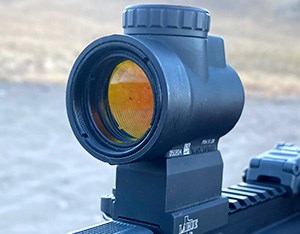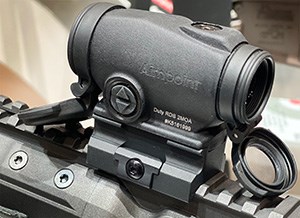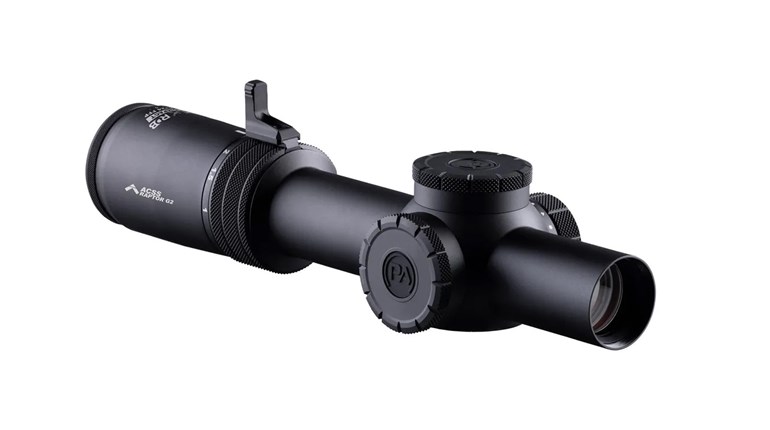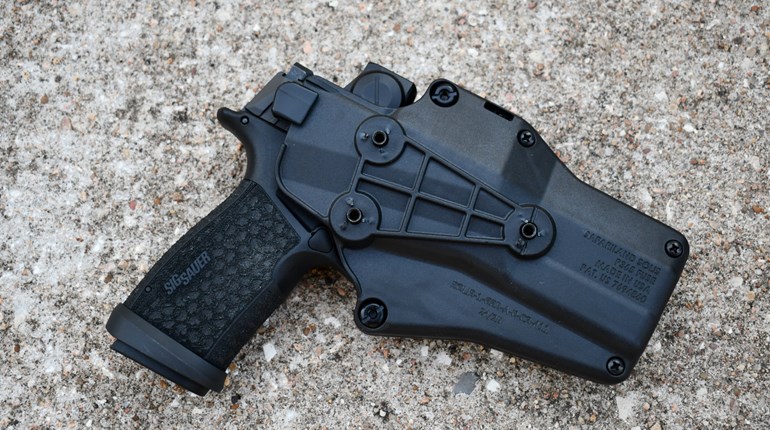
These days, all kinds of optics are available for both defensive and general-purpose carbines, but arguably the red-dot [reflex] sight and the LPVO [low power variable optic] are the most popular. Both have their strengths and weaknesses, but ultimately their aim is the same: helping shooters put rounds on target. Red-dot sights are built for quick, close-distance shots while LPVOs are intended to be both quick up close with the added ability to magnify targets further away.
LPVOs
Low Power Variable Optics have grown in popularity within the last decade in the American shooting landscape. Before hitting the mainstream, LPVOs were held in high regard not only by elite military units, but also with serious competitors. This type of riflescope gives the shooter the capability to make quick shots at closer distances with the added benefit of being able to reach out to farther targets. Depending on the make or model, LPVOs can have varying magnification ranges from 1 power to 4, 6, 8 or even 10 power. Likewise, their tube diameters can vary between 30mm, 34mm or 35mm. They tend to have an illuminated reticle powered by a coin-type battery. Nearly all LPVOs have capped turrets that are not quickly adjustable, as these scopes are meant for fast, reactive engagements, and shooters do not dial turrets and instead use their reticles for holdovers. Depending on make and model, these reticles may be either first or second focal plane, no different than traditional riflescope reticles.
 Red Dot Sights
Red Dot Sights
Red-dot sights are available across all price points and for every use including recreation, competition or serious duty use. Red-dot sights are fairly straightforward, as they usually have no magnification and their reticles tend to be singular red or green “dots” that are typically between 2 to 4 MOA in size. These electronic sights work simply; they reflect (or in the case of holographic sights, project) either an LED or laser reticle onto an internal surface within the sight. When a shooter looks through the sight, they see the reflected/projected reticle with both eyes open while focusing on their target. Because red-dot sights are intended to be shot with both eyes open and using target-focus, they are considerably faster to employ than traditional iron sights, which entail lining up the rear sight with the front sight and target for the correct sight picture. The neat thing about red-dot sight pictures is that shooters don’t have to be squarely lined up with their electronic sight for a good sight picture. As long as the shooter can see the dot and place it on their target, the sight picture is “valid.” Red-dots facilitate shooting in contorted or unconventional positions in ways that iron sights (or LPVOs to a lesser degree) cannot.
Comparing The LPVO To The Red Dot
 When directly comparing LPVOs vs. red-dots, red-dot sight will generally be “faster” and more forgiving to use because they aren’t the type of optic where eye-relief or the eye-box is a concern for a proper sight picture. In the same vein, this makes the mounting position of red-dots more flexible than the mounting position of LPVOs. Factoring in price, even premium red-dot sights typically cost less than their comparable high-end LPVO counterparts as well. This is also true of red-dot mounts and bases in comparison to LPVO scope bases. Red-dot optics tend to weigh less and are smaller than the typical LPVO. Due to their simple nature, a red dot has fewer parts than an LPVO, meaning less parts are at risk of failure. The biggest downside of red-dots is their lack of magnification or sophisticated reticles. At close distances, this issue is negligible. At further distances this downside means losing precision and the ability to zoom in onto the target or landscape. Adding magnifiers to red dots reduces some of these concerns, but those devices also present their own challenges, such as the distortion of the red dot and and a limited usefulness at longer ranges. For example, most magnifiers are useful out to around 300 yards, whereas most LPVOs are useful to double that distance.
When directly comparing LPVOs vs. red-dots, red-dot sight will generally be “faster” and more forgiving to use because they aren’t the type of optic where eye-relief or the eye-box is a concern for a proper sight picture. In the same vein, this makes the mounting position of red-dots more flexible than the mounting position of LPVOs. Factoring in price, even premium red-dot sights typically cost less than their comparable high-end LPVO counterparts as well. This is also true of red-dot mounts and bases in comparison to LPVO scope bases. Red-dot optics tend to weigh less and are smaller than the typical LPVO. Due to their simple nature, a red dot has fewer parts than an LPVO, meaning less parts are at risk of failure. The biggest downside of red-dots is their lack of magnification or sophisticated reticles. At close distances, this issue is negligible. At further distances this downside means losing precision and the ability to zoom in onto the target or landscape. Adding magnifiers to red dots reduces some of these concerns, but those devices also present their own challenges, such as the distortion of the red dot and and a limited usefulness at longer ranges. For example, most magnifiers are useful out to around 300 yards, whereas most LPVOs are useful to double that distance.
Although LPVOs tend to be more expensive, heavier and complex, they allow the shooter to use carbines from close distances all the way to the effective range of the rifle, usually 400 to 500 yards. LPVO magnification isn’t just for shooting more precisely, but also allows the shooter to PID (positively identify) targets or places. LPVOs are equipped with useful first or second focal plane illuminated reticles with stadia lines and subtensions to help make precise shots at distance. To prepare for this article, I recently attended Green Ops’ 2-Day LPVO carbine course. Michael Green, the founder of Green Ops, told me that he and his staff spent time developing the curriculum to not only challenge the red-dot as the “go-to” optic for the carbine, but to also showcase everything else the LPVO can do. At the Green Ops LPVO course, we spent plenty of time shooting both at CQB and extended distances, with instructors demonstrating how to use reticles correctly to shoot proficiently at both types of ranges. I left the course with new insights, both my own and from the instructors’ own professional experiences.
The Takeaway
Green and the Green Ops instructors could tell you that mastering the LPVO takes considerably more work than a red dot, and I witnessed this first-hand at their course. To really shoot smoothly with an LPVO, the position of the optic relative to one’s head and eyes has to be perfect. After all, LPVOs work like any other riflescope, and if the eye isn’t behind the exit pupil correctly and at the proper relief, the shooter will see a scope shadow or possibly nothing at all. In the case of odd shooting positions such as shooting over barricades, I experienced how crucial having the correct height scope mount was, lest the optic not be aligned properly with my eyes. These quirks were further amplified when shooting under the stress of a shot-timer.
Directly comparing the LPVO vs the red-dot, the LPVO is the more sophisticated sighting system. It works both up close and at distance, with the added ability to zoom in on targets or the landscape. Although their reticles help with further shots, they aren’t sniper scopes, nor are they used that way. Aside from being more expensive, they work like any other scope so proper eye-relief and exit-pupil alignment is key. Like the Green Ops instructors told me, LPVOs take more effort to master but deliberate practice and repetition help with that. Red-dot sights still beat LPVOs on quickness and cost along with the fact that they’re more intuitive to use. As the old saying goes, “mission drives gear” and fielding an LPVO vs. a red-dot will ultimately depend on the task at hand. If the maximum distances you expect to shoot are relatively short, the red-dot makes the most sense. However, there’s something to be said for how an LPVO lets you take the full advantage of the effective range of your carbine





































